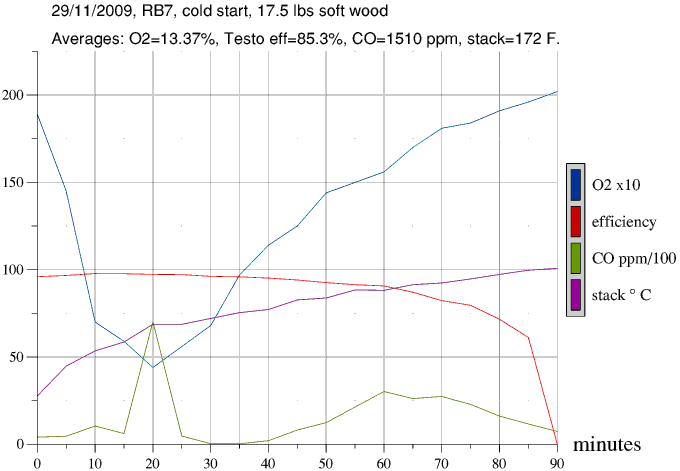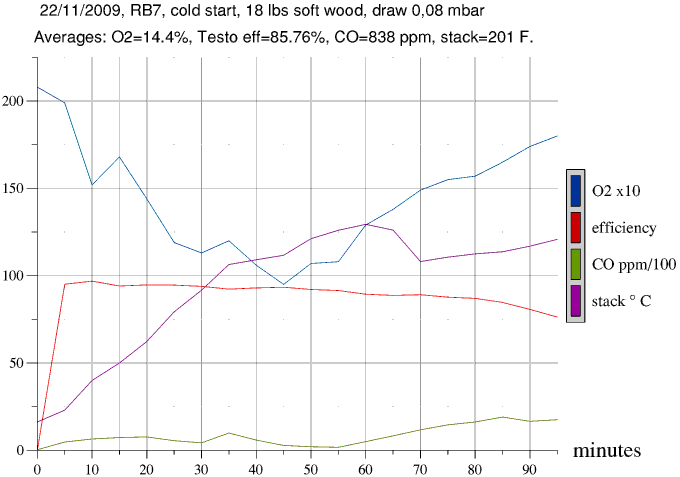Date: Sun, 06 Dec 2009
From: Peter van den Berg <peter(at)pberg.demon.nl>
To: mheat(at)heatkit.com
Subject: rocket/bell project
Hi Norbert,
Last month I've spent some time in order to fine-tune the rocket/bell. Mainly to be able to get it started without heating up the stack with a torch.
So far it's going remarkably well. I've prepared graphics of four test runs, to illustrate the results. I've filled in the Condar spreadsheet as well. The fourth run, which was the dirtiest had also the lowest flue temp and is therefore the best with efficiency.
Note the similarities in the graphics, mainly in the CO line. There is always a small bump in the beginning, then a fairly extensive valley and a bigger bump at the end. The differences in O2 and stack temp are caused by fiddling with the air intake. In particular, the ratio between under air, front air and side air. The hotter the thing gets the more the emphasis will be on the side air.
The fourth graph do show a sharp peak of carbon monoxide in the startup phase with an oxygen level less than 5%. In this particulair case the side-air intake wasn't large enough. As a result, the siphon couldn't get sufficient air while the temperature was high enough. The interval of the graph is 5 minutes, while the peak actually lasted much shorter, something in the order of 2 minutes. It went down really as sharp as it went up. The conclusion seems to be: the oxygen level has to stay above 5%. When it's getting lower the likelihood of significant CO peaks are higher.
This fact do limit the maximum efficiency. Two factors play a role in here: the amount of air that need to be heated and the temperature that's discharged through the chimney. It seems to be better that the oxygen is higher than 5%, and during the top of the burn at least 140 degrees Fahrenheit to the chimney is needed. This results in a maximum yield of 97%, according to the Testo equipment. Some more and the fire behavior is getting unpredictable.
Above each graph are the averages of that combustion run. Based on the graphs it's clear that it is not needed necessarily to have a low CO level in order to achieve high efficiencies. Of course, the quality of the combustion is better at a low CO level. After a cold start with outside temperatures below 50 F., a lot of water vapor's escaping the chimney which simply do resolve within five feet.
Lighting the thing is always the same: stacking the wood to the edge of the siphon and on top of that a small fire of which the flames instantly disappearing into the siphon. In that way, it warms up quickly with an average value of 900 F. in 12 minutes. Opening the door at the height of the burn is not a good idea. As the siphon is lower than the top of the door, part of the smoke will come into the room.
At the moment I have no recent graphs of a testrun which has had a refill. This do provide a complete show with generally very low numbers of CO and O2. All the wood burns simultaneously, but large jumps in the different values remain absent. The thing will make a lot of noise, a kind of dull roar.
The oxygen will go lower than the limit of 5% in about half of the instances. Without the major peaks in the carbon monoxide readings. The dangerous point is thus mainly during the cold start, as the side aeration and the syphon are not hot enough yet.
The mantle of the experimental model will be quite hot after a refill. The double walled side, in total 5 1/4" refractory castable, has reached 230 F. at one occasion. At the front, about 4" above the steel door frame 275 F. during the same run. During such sessions the syphon will exit between 1560 and 1790 degrees Fahrenheit inside the stove. What the temperature at the hottest spot will be I don't know, I don't have a sensor in there. That would also be futile, the sensors I'm using cannot bear more than 1830 degrees F.
This article is translated from Dutch by google translate, like Eric Moshier suggested. I sincerely do hope it has become readable English after extensive editing by me.
regards, Peter
|





